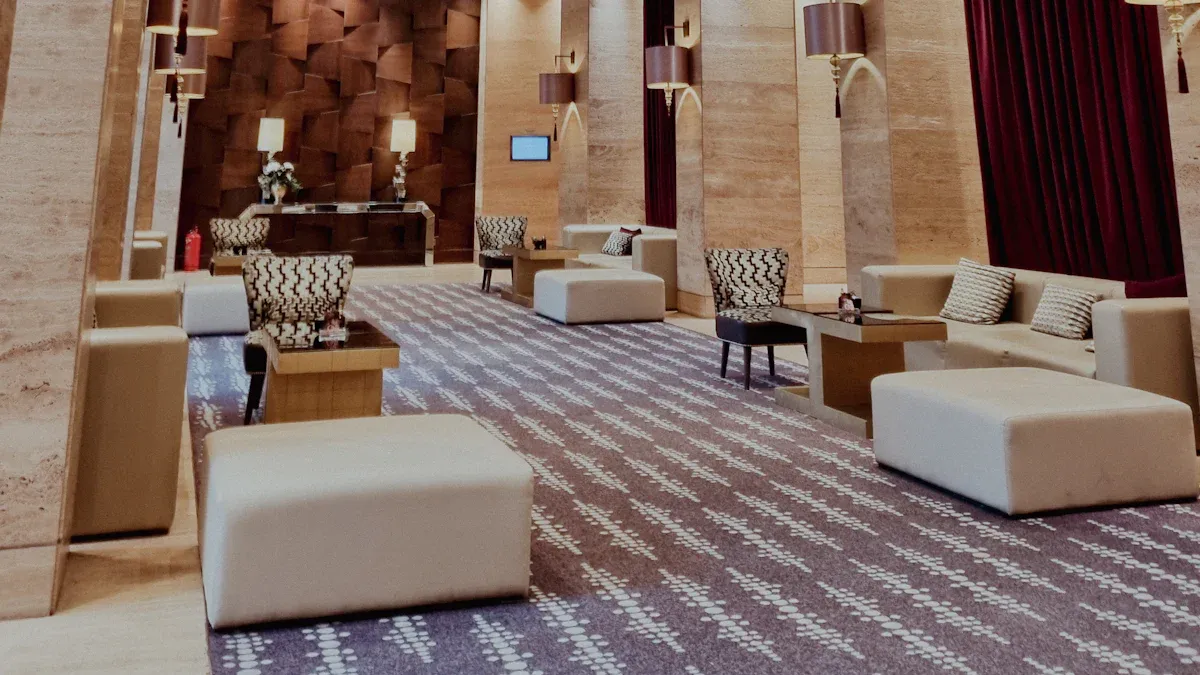
Induction lamp technology transforms hospitality lighting by delivering long-lasting performance and vivid brightness. Hotels use Motion Sensor Lights and Smart Security Lights in corridors and entrances for safety. Automatic Lighting and Energy-Saving Outdoor Sensor Lights reduce energy use and maintenance. The table below highlights key benefits compared to other lighting types:
| Feature | Induction Lamps | Fluorescent Lamps | Metal Halide Lamps |
|---|---|---|---|
| Lifespan | Up to 100,000 hours; retains ~70% output at 60,000 hours | About 14,000 hours (T12HO fluorescent) | 7,500 to 20,000 hours |
| Internal Components | No internal electrodes; uses high-frequency generator | Uses electrodes that degrade over time | Uses electrodes that degrade over time |
| Light Quality | High Scotopic/Photopic (S/P) ratio; appears brighter to human eye due to better alignment with night vision sensitivity | Lower S/P ratio; light meters may overestimate brightness | Lower S/P ratio; less visually effective brightness |
| Energy Efficiency | Uses ~50% less energy than comparable conventional lamps | Moderate efficiency | Moderate efficiency |
| Visual Effectiveness | Produces visually effective lumens (VEL) that enhance visual acuity and ambiance | Less visually effective lumens | Less visually effective lumens |
Key Takeaways
- Induction lamps save energy and reduce costs by using up to 50% less power and lasting up to 100,000 hours, which means fewer replacements and lower maintenance.
- These lamps provide bright, natural light that improves guest comfort and safety with instant-on features and high color quality, making spaces welcoming and visually appealing.
- Hotels use induction lamps in smart systems for lobbies, outdoor areas, service zones, and emergency lighting to enhance efficiency, security, and guest experience while supporting sustainability goals.
Induction Lamp Advantages in Hospitality Lighting
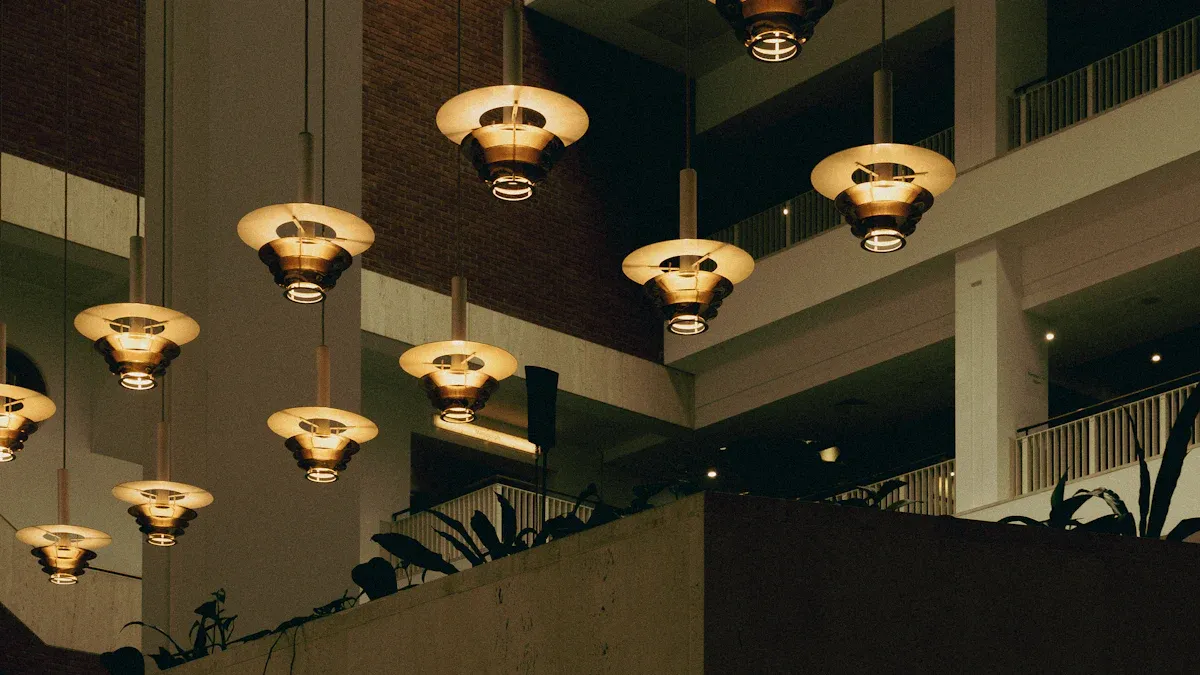
Energy Efficiency and Cost Savings
Induction lamps deliver significant energy savings for hospitality businesses. They use up to 50% less energy than traditional HID lamps, which directly lowers electricity bills. Over a five-year period, hotels and resorts see a faster return on investment because of these savings. The long lifespan of induction lamps—up to 100,000 hours—means fewer replacements and less frequent maintenance. This reduces both labor and equipment costs.
Tip: Induction lamps maintain 88% of their light output throughout their life, so spaces stay bright and welcoming without frequent bulb changes.
Although the initial cost of an induction lamp is higher than some conventional options, it is lower than many LED systems. The higher light output also means fewer fixtures are needed, which further reduces installation and operational costs. Over time, the combination of energy efficiency, durability, and low maintenance makes induction lamps a smart financial choice for hospitality lighting projects.
| Lighting Technology | Energy Efficiency (lm/W) | Lifespan (hours) | Maintenance Frequency |
|---|---|---|---|
| Incandescent | 10-17 | 1,000-2,000 | High |
| Fluorescent | 50-100 | 8,000-10,000 | Medium |
| Induction Lighting | 80-120 | 50,000-100,000 | Low |
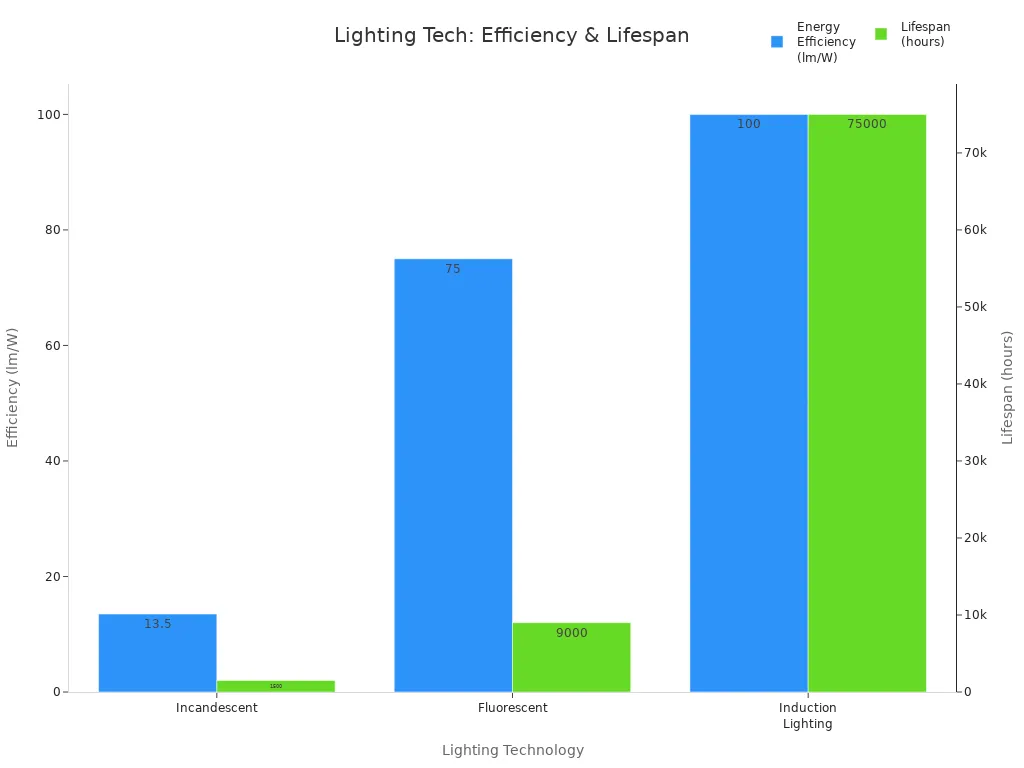
Longevity and Low Maintenance
Hospitality environments operate around the clock, so lighting reliability is essential. Induction lamps stand out because of their exceptional longevity. Many models last up to 100,000 hours, which equals about 11 years of continuous use. This long service life means hotel managers spend less time and money on lamp replacements and maintenance.
Induction lamps also resist vibration and temperature changes, making them ideal for busy areas like kitchens, hallways, and outdoor spaces. Their instant-on feature ensures that lights reach full brightness immediately, which is important for guest safety and convenience. Because induction lamps require fewer replacements, hotels can reduce labor costs and avoid disruptions to guests.
Superior Light Quality and Guest Comfort
Lighting quality shapes the guest experience in hotels, restaurants, and resorts. Induction lamps provide high color rendering index (CRI) values, usually between 85 and 90. This means colors appear natural and vibrant, which enhances the look of lobbies, dining areas, and guest rooms. The high Scotopic/Photopic (S/P) ratio of induction lamps improves visibility and visual comfort, especially in low-light settings.
Indirect lighting with induction lamps creates soft, glare-free illumination that highlights architectural features and sets a welcoming mood. Unlike some traditional lighting, induction lamps do not flicker, so guests enjoy a stable and comfortable environment. This quality is especially important in hospitality spaces where ambiance and visual appeal matter.
| Lighting Technology | Scotopic/Photopic (S/P) Ratio | Color Rendering Index (CRI) |
|---|---|---|
| High Pressure Sodium | 0.5 | 24 |
| Warm White Fluorescent | 1.0 | 50-90 |
| Metal Halide | 1.49 | 65 |
| Incandescent | 1.41 | 100 |
| 5000K Induction Lamp | 1.96 | 85-90 |
| LED | N/A | 80-98 |
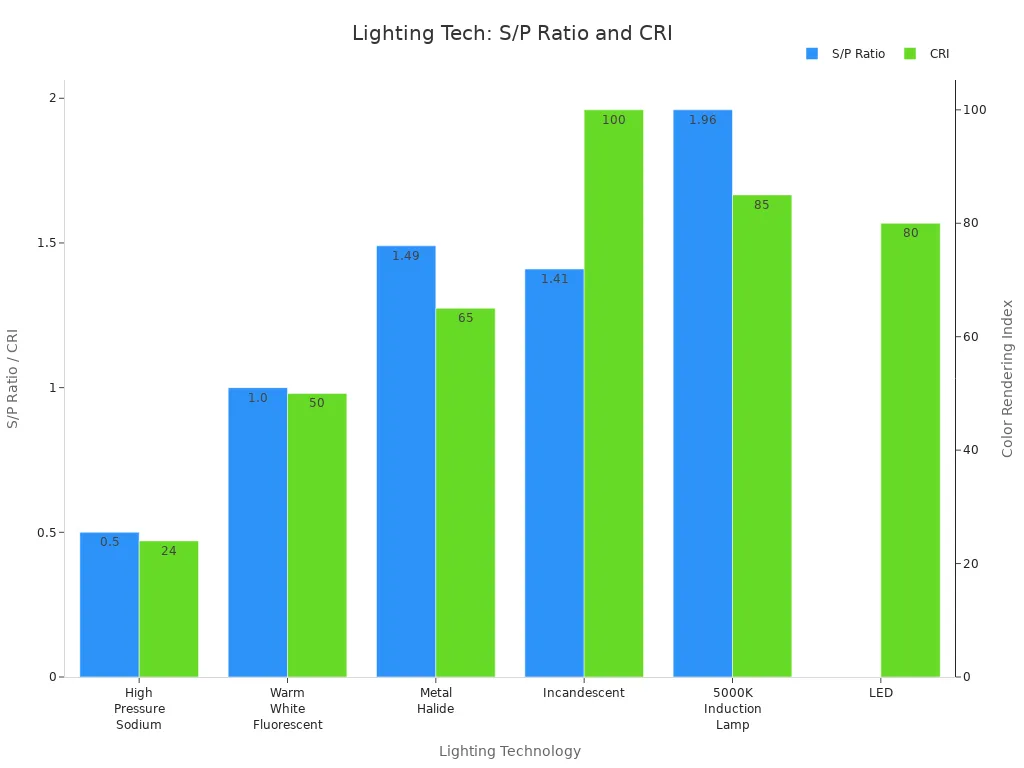
Innovative Induction Lamp Applications in Hospitality Spaces
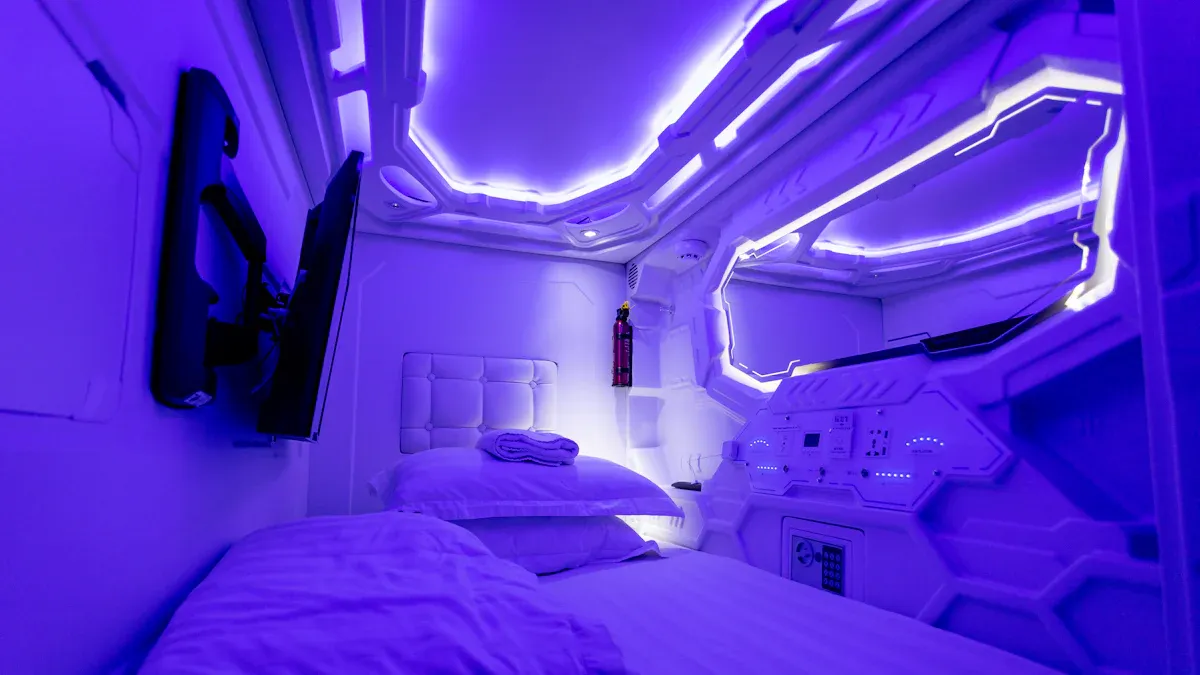
Ambient and Mood Lighting in Lobbies and Lounges
Lobbies and lounges set the first impression for guests. Hotels use induction lamp systems to create inviting and flexible lighting scenes. These lamps provide soft, even illumination that highlights architectural features and artwork. Many properties now integrate induction lamps with smart controls. This technology allows staff to adjust brightness and color temperature for different times of day or special events.
- Induction lamps paired with 5.8GHz microwave motion sensors automatically adjust lighting based on guest presence.
- Guests enjoy a welcoming atmosphere as lights brighten when they enter and dim when areas are empty.
- Remote and central controls let staff or guests select modes like reading or relaxation, enhancing comfort.
This approach reduces energy waste and creates a warm, home-like environment. The lighting remains stable and flicker-free, which helps guests feel at ease. Ninghai County Yufei Plastic Electric Appliance Factory supplies advanced induction lamp solutions that support these smart features, helping hotels deliver memorable guest experiences.
Outdoor and Landscape Induction Lamp Solutions
Outdoor spaces such as gardens, pathways, and parking lots require reliable and efficient lighting. Induction lamp technology excels in these environments. The lamps withstand temperature changes and resist vibration, making them ideal for outdoor use. Their long lifespan means fewer replacements, even in harsh weather.
Hotels use induction lamps to illuminate walkways, highlight landscaping, and improve safety. The high color rendering index ensures that plants and outdoor features look vibrant at night. Motion sensors can activate lights only when needed, saving energy and reducing light pollution.
Note: Microwave sensors in induction lamp systems penetrate walls and obstacles, ensuring no dark spots in outdoor corridors or entrances. This feature improves guest safety and prevents accidents.
Ninghai County Yufei Plastic Electric Appliance Factory offers outdoor induction lamp products designed for hospitality landscapes, combining durability with energy savings.
Back-of-House and Service Area Lighting
Service areas such as kitchens, laundry rooms, and storage spaces need dependable lighting for staff efficiency and safety. Induction lamp systems provide instant-on illumination, so workers never wait for lights to reach full brightness. The lamps maintain high output over time, reducing the need for frequent maintenance.
Hotels benefit from the low maintenance requirements of induction lamps in these busy areas. Automated controls further improve efficiency by turning lights off or dimming them when spaces are unoccupied. This reduces operational costs and supports sustainability goals.
A table below shows key benefits for back-of-house applications:
| Feature | Benefit for Service Areas |
|---|---|
| Instant-on | No waiting for full brightness |
| Long lifespan | Fewer replacements needed |
| Vibration resistance | Reliable in busy environments |
| Automated controls | Lower energy and maintenance |
Emergency and Security Induction Lamp Systems
Safety remains a top priority in hospitality settings. Induction lamp systems play a vital role in emergency and security lighting. These lamps provide reliable, flicker-free illumination during power outages or emergencies. Their instant-on feature ensures that corridors, stairwells, and exits remain well-lit at all times.
Hotels often integrate induction lamps with smart sensors to prevent sudden darkness in critical areas. Microwave motion sensors detect movement and keep lights on when guests or staff are present. This reduces the risk of accidents and enhances overall security.
Automated emergency lighting systems also support compliance with green building certifications, such as LEED and WELL. Ninghai County Yufei Plastic Electric Appliance Factory delivers induction lamp solutions that meet strict safety and sustainability standards, helping hotels protect guests and staff while improving their brand image.
The hospitality industry continues to adopt next-generation lighting for guest comfort and efficiency.
- Hotels and restaurants seek modern solutions that support sustainability and safety.
- Market growth is driven by new technology, rising incomes, and urbanization.
- Experts expect adoption to increase as innovation and partnerships expand product choices.
By: Grace
Tel: +8613906602845
E-mail: grace@yunshengnb.com
Youtube: Yunsheng
TikTok: Yunsheng
Facebook: Yunsheng
Post time: Jul-18-2025
